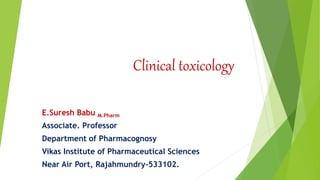
GENERAL PRINCIPLES OF POISONING.pptx
- 1. Clinical toxicology E.Suresh Babu M.Pharm Associate. Professor Department of Pharmacognosy Vikas Institute of Pharmaceutical Sciences Near Air Port, Rajahmundry-533102.
- 3. TOXICOLOGY It is the study of poisons. • Poisons are chemical/physical agents that produce adverse responses in biological organisms. Any substance can be toxic if introduced in a dose capable of disturbing the normal physiological homeostasis of the exposed body
- 4. Toxins Toxins are poisonous substance produced within living cells or organisms – Venom
- 5. Toxicants Toxicants are toxic substances from chemicals.
- 6. Toxicology Toxicology The science of poisons that studies toxic substances with respect to their: • Sources • Properties • Mechanism of toxicity • Toxic effects • Detection • Clinical manifestations • Management
- 7. Sources Chemical Source: the commonest source e.g. drugs, corrosives Plant Source: e.g. hashish, cocaine Animal Source: the least but most serious source. Venomous animals such as scorpions, spiders, snakes, wasps.
- 8. Venomous & Poisonous Animals Venomous animals deliver or inject venom into other organisms, using a specialized apparatus of some kind (usually fangs or a stinger). The venom is produced in a gland attached to this apparatus. Poisonous animals do not deliver their toxins directly. The entire body, or large parts of it, may contain the poisonous substance.
- 9. These organisms may be harmful when eaten or touched. Wasp sting (VENOM) Androctonus bicolor Cerastes vipera Tetradotoxin in Puffer Fish
- 14. Sites of Toxic Actions • Local (non-specific): Wherever the poison contacts the biological system it starts its harmful effects. It does not require specific site or receptor to elicit its effects such as toxicity by acids or alkalis. • Remote (systemic): The poison affects a system far from its portal of entry. • Local & Remote: The poison has the capacity of acting locally and systematically. Oxalic acid is an example of these poisons.
- 15. Duration and frequency of exposure Acute: application of a single or short- term (less than a day) dosing of a substance to cause toxicity. Sub-acute: toxicity is expressed after repeated applications for a duration less than half-life expectancy. Chronic: Expression of toxic symptoms only after repeated exposure to a chemical in doses regularly applied to the organism for a time greater than half of its life- expectancy
- 16. Chronicity Index The ratio of the acute to chronic LD50 dosage. Compounds with strong cumulative properties have larger chronicity index.
- 17. Types of Toxic Mechanisms Direct: the poison itself can cause toxic effects as in corrosives. Indirect: toxicity results from the interaction of the poison with the biological activity within biological system. Binding to cell membrane to change in their function or structure thus affecting their normality. Interference with enzymatic actions. Formation of metabolites which are more toxic than the parent poison. Effects on DNA
- 18. Classification of toxic agents 1) According to the Target organ they are acting on it (hepatotoxic, Nephrotoxic) 2) According to their Use (food additive, drug, pesticide) 3) According to their Source (animal or plant) 4) According to their Effects (carcinogen, mutagen)
- 19. Classification of toxic agents 5) According to their Physical state (gas, liquid) 6) According to their Chemistry (Amine, hydrocarbon) 7) According to their Poisoning potentiality (extremely toxic, slight toxic, etc). 8) According to their Biochemical mechanism of action (alkylating agent, AchE inhibitor)
- 20. Factors Affecting Action of Poison A) Factors related to the poison: • Dose: a basic principle in toxicology. – Dose is the amount of chemical that comes into contact with the body or gets inside the body. – The increase of dose will increase the severity of toxicity. • Physical status Gaseous state is more toxic than liquid state than the solid state. • Purity: this depends on the impurity of the poison; if the impurities are more toxic than the poison, the toxicity will be more and vice versa
- 21. B) Factors related to the individual: – Age – Health – Sensitivity – Sex C) Factors related to mode of exposure: – Inhalation > IM > ingestion > Skin contact D) Factors related to environment: – Temperature, pressure, humidity, radiation can cause alterations on poisons status
